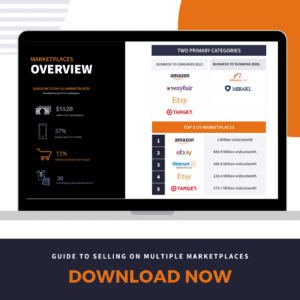Learn why you should be selling on Walmart Marketplace and how to sell on Walmart with Shopify’s app.
How to Sell on Walmart with Shopify


Why You Should be Selling on Walmart Marketplace
With 120 million visits to Walmart.com every month, Walmart Marketplace is quickly becoming one of the largest retail platforms, second only to Amazon. Walmart has more than doubled the number of third party sellers on Walmart Marketplace in 12 months.
With the introduction of its subscription service, Walmart+, in September of 2020, Walmart introduced a major new competitor to Amazon Prime. With an estimated 11.5 million subscribers, Walmart+ should not be overlooked by ecommerce sellers looking to compete in the marketplace. Walmart+ members are loyal shoppers:
- 29% of consumers prefer Walmart to Amazon or Target
- Walmart+ subscribers spend almost twice as much money as non-subscribers on Walmart.com
- Walmart+ subscribers shopped on Walmart.com an average of 11 times more per year than non-subscribers
And with no upfront fees for listing, this opportunity is low-risk for a small to medium-sized retailer. Walmart has even launched partnerships with major ecommerce platforms like Shopify to make setting up and managing Walmart Marketplace listings as simple as possible.
Read ahead to learn how to sell on Walmart with Shopify, how to manage multiple sales channels, and how to meet customer expectations for Walmart Marketplace.
How to Sell on Walmart with Shopify
Shopify merchants may apply to sell through Walmart.com by adding the Walmart app and completing the application process. Walmart Marketplace has said that they’re looking for “relationships with reputable retailers and brands that provide first-class customer service, a compelling product assortment, competitive pricing and fast, reliable fulfillment.”
Among Walmart’s standards for customer service are a prompt response to customer inquiries (within 24 hours) with high-quality (not automated) responses, on-time shipment rates of at least 99%, and sku-level inventory updates with at least 99% accuracy. Minimum business requirements for the application are: US Business Tax ID (EIN) and Form W-9, a history of marketplace or eCommerce success, a track-record of first-class customer service, and operations that meet Walmart Seller Performance Standards.
Once approved, a Shopify merchant can activate their Walmart seller channel and manage all listings and inventory directly through the Shopify dashboard. Product listings can be imported in bulk, and existing Walmart Marketplace listings can be linked to Shopify products to allow merchants to centrally manage all listings. Products listed must meet the following minimum requirements:
- Have GTIN/UPC GS1 Company Prefix Number
- Be competitively priced
- Be fulfilled from a B2C US warehouse with a returns capability
- Comply with Walmart Prohibited Products policy.
Walmart order notifications, fulfillment, and inventory management are all handled through the Shopify dashboard, creating a truly integrated experience for merchants and shoppers alike.
Who Are Walmart Marketplace Shoppers?
Although, Walmart has focused on increasing their grocery sales, finally overtaking Amazon for the number one spot in 2020, their focus on growing their marketplace sellers indicates that they are committed to diversifying their product selection. According to a recent consumer survey, Walmart shoppers are looking for:
- Groceries/Perishables (59%)
- Clothing/Cosmetics (57%)
- Cleaning Supplies/Essential Items (55%)
- Electronics/Appliances (42%)
- Pet Products (37%)
- Furniture (23%)
According to the survey, Walmart Shoppers’ fulfillment expectations are:
- Free shipping on all purchases (55%)
- 2-day shipping on all purchases (53%)
- In-store pickup for all purchases (41%)
Adding a New Sales Channel
Shopify merchants who aren’t already selling on a marketplace like Walmart could be missing out on valuable brand exposure. According to a study by UPS Capital, 97% of SMBs drove revenue through more than one platform last year, and 54% were selling on Walmart Marketplace. Today’s consumers are shopping and discovering new products everywhere. Savvy merchants will be getting their products in front of them on as many channels as possible to increase brand awareness.
Adding an additional sales channel can be intimidating for SMBs, but the solution is to streamline and simplify as many processes as possible. Shopify has made it easy for merchants to sell on Walmart and manage their Walmart and Shopify sales through a single dashboard.
Similarly, streamlining order fulfillment through a single outsourced fulfillment partner, allows you to manage all of your outbound orders and inventory through a single network. And a fulfillment provider with a flexible technology platform will be able to integrate with your Shopify store for automatic order processing, tracking notifications, and more.
Streamlining your fulfillment through a single provider will also allow you to create the same customer experience across all of your sales channels. Consumers should know to expect fast and affordable delivery from your brand no matter where they’re shopping. They should also receive your product in your branded packaging to reinforce your brand.
Is your Shopify store ready to list on Walmart Marketplace?
Walmart has established itself as an industry leader and legacy brand through its history of competitive pricing and high standards of customer service, and Walmart Marketplace expects its online merchants to uphold the same standards of service. Their SLAs require order acknowledgment within 4 hours of purchase, order shipment by the end of the next business day, on-time shipment rates of 99%, and accurate tracking information.
Another important consideration for Shopify merchants is whether their listings will be able to compete in a large marketplace like Walmart’s or get lost in a sea of competing listings. One major competitive differentiator is free 2-day delivery. According to Walmart, merchants who enroll in their seller-fulfilled 2-day delivery program are 36% more likely to win the Buy Box and beat out competitors’ listings.
An on-demand fulfillment partner can level the playing field for businesses of all sizes to offer low-cost 2-day delivery by connecting merchants with a nationwide network of warehouses, allowing them to forward stock their inventory closer to their customers to improve delivery speed. And a platform like Ware2Go’s will integrate seamlessly with an existing Shopify store to further streamline operations from sale to delivery. A robust and flexible API enables a fully automated integration that conforms readily to existing operations. Additionally, a team of logistics experts creates a custom fulfillment network for each merchant based on historical sales data to expand their 2-day delivery footprint without significantly increasing their shipping costs.
Click here to learn more about Ware2Go’s on-demand warehousing solution. To find out how Ware2Go can integrate with your Shopify store reach out to one of our logistics experts.


